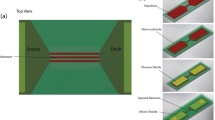Abstract
Nanowire (NW) detection is one of the fast and highly sensitive methods. An NW biosensor based on silicon-on-insulator (SOI) structures are used in the reported study for real-time label-free biospecific detection of the NFATc1 (D-NFATc1) cancer marker. For this purpose, the SOI NWs are functionalized with NFATc1 aptamers used as macromolecular probes. It is demonstrated that such a biosensor can ensure a detection limits up to 10−15 M, which is comparable with the sensitivity ensured by an NW biosensor with immobilized antibodies used as macromolecular probes. The results of this study demonstrate that such approaches to the development of sensor elements for highly sensitive diagnostics of diseases are really promising.
Similar content being viewed by others
References
Y. D. Ivanov, N. S. Bukharina, P. A. Frantsuzov, et al., “AFM Study of Cytochrome CYP102A1 Oligomeric State,” Soft Matter. 8(17), 4602–4608 (2012).
Yu. D. Ivanov, P. A. Frantsuzov, A. Zollner, et al., “Atomic Force Microscopy Study of Protein-Protein Interactions in the Cytochrome CYP11A1 (P450scc)-Containing Steroid Hydroxylase System,” Nanoscale Res. Lett. 6(1), 54–67 (2011).
Yu. D. Ivanov, P. A. Frantsuzov, V. A. Bykov, et al., “Comparative Interactions of PdR by Usual and Ultrafine Atomic Force Microscopy,” Anal. Meth. 2(6), 688–693 (2010).
Y. D. Ivanov and A. I. Archakov, “Application of AFM and Optical Biosensor for Investigation of Complexes Formed in P450-Containing Monooxygenase Systems,” Biochim. Biophys. Acta 1814(1), 102–110 (2011).
A. I. Archakov and Y. D. Ivanov, “Optical Biosensor and Scanning Probe Microscopy Studies of Cytochrome P450 Interactions with Redox Partners and Phospholipid Layers,” Methods Enzymology 357(Pt. C), 94–103 (2002).
A. M. Armani, R. P. Kulkarni, S. E. Fraser, et al., “Label-Free, Single-Molecule Detection with Optical Microcavities,” Science 317(5839), 783–787 (2007).
H. R. Sim, A. W. Warkb, and H. J. Lee, “Attomolar Detection of Protein Biomarkers Using Bio-Functionalized Gold Nanorods with Surface Plasmon Resonance,” Analyst. 135(10), 2528–2532 (2010).
L. Rodríguez-Lorenzo, R. de la Rica, R. A. Álvarez-Puebla, et al., “Plasmonic Nanosensors with Inverse Sensitivity by means of Enzyme-Guided Crystal Growth,” Nature Materials 6(11), 604–607 (2012).
G. Zheng, F. Patolsky, Y. Cui, et al., “Multiplexed Electrical Detection of Cancer Markers with Nanowire Sensor Arrays,” Nature Biotechnol. 23(10), 1294–1301 (2005).
Yu. D. Ivanov, T. O. Pleshakova, A. F. Kozlov, et al., “SOI Nanowire for the High-Sensitive Detection of HBsAg and a-Fetoprotein,” Lab on a Chip 12(23), 5104–5111 (2012).
F. Patolsky, G. F. Zheng, O. Hayden, et al., “Electrical Detection of Single Viruses,” Proc. USA National Acad. Sci. 101(39), 14017–14022 (2004).
N. Elfstrom, R. Juhasz, I. Sychugov, et al., “Surface Charge Sensitivity of Silicon Nanowires: Size Dependence,” Nano Lett. 7(9), 2608–2612 (2007).
J. Hahm and C. M. Lieber, “Direct Ultrasensitive Electrical Detecion of DNA and DNA Sequence Variations Using Nanowire Nanosensors,” Nano Lett. 4(1), 51–54 (2004).
T.-S. Pui, A. Agarwal, F. Ye, et al., “Ultra-Sensitive Detection of Adipocytokines Secreted from Adipocytes with CMOS-Compatible Silicon Nanowire Arrays,” Nanoscale 1(1), 159–163 (2009).
S. Carrara, D. Sacchetto, M. A. Doucey, et al., “Memristive-Biosensors: A new Detection Method by Using Nanofabricated Memristors,” Sens. Actuators B 171–172(1), 449–457 (2012).
E. N. Brody and L. Gold, “The Use of Aptamers in Large Arrays for Molecular Diagnostics,” Mol. Diagn. 4(4), 381–388 (1999).
R. Y. Lai, K. W. Plaxco, and A. J. Heeger, “Aptamer-Based Electrochemical Detection of Picomolar Platelet-Derived Growth Factor Directly in Blood Serum,” Anal. Chem. 79(1), 229–233 (2007).
E. W. Ng, D. T. Shima, P. Calais, et al., “Pegaptanib, a Targeted Anti-VEGF Aptamer for Ocular Vascular Disease,” Nat. Rev. Drug Discov. 5(2), 123–132 (2006).
T. An, K. S. Kim, S. K. Hahn, and G. B. Lim, “Real-Time, Step-Wise, Electrical Detection of Protein Molecules Using Dielectrophoretically Aligned SWNT-Film FET Aptasensors,” Lab on a Chip 10(16), 2052–2056 (2010).
X. Luo, I. Lee, J. Huang, et al., “Ultrasensitive Protein Detection Using an Aptamer — Functionalized Single Polyaniline Nanowire,” Chem. Commun. 47(22), 6368–6370 (2011).
K. S. Kim, H.-S. Lee, L.-A. Yang, et al., “The Fabrication, Characterization and Application of Aptamer — Functionalized Si-Nanowire FET Biosensors,” Nanotechnol. 20(23), 235501 (2009).
G. K. Yiu, A. Kaunisto, Y. R. Chin, and A. Toker, “NFAT Promotes Carcinoma Invasive Migration through Glipican-6,” Biochem. J. 440(1), 157–166 (2001).
A. Jolma, T. Kivioja, J. Toivonen, et al., “Multiplexed Massively Parallel SELEX for Characterization of Human Transcription Factor Binding Specificities,” Genome Res. 20(6), 861–873 (2010).
O. V. Naumova, B. I. Fomin, D. A. Nasimov, et al., “SOI Nanowires as Sensors for Charge Detection,” Semiconductor Sci. Technol. 25(5), 055004 (2010).
O. V. Naumova, B. I. Fomin, L. N. Safronov, et al., “Silicon Nanowire Transistors for Electron Biosensors,” Avtometriya 45(4), 6–11 (2009) [Optoelectron., Instrum. Data Process. 45 (4), 287–291 (2009)].
M.-H. Lee, D.-H. Lee, S.-W. Jung, et al., “Measurements of Serum C-Reactive Protein Levels in Patients with Gastric Cancer and Quantification Using Silicon Nanowire Arrays,” Nanomed.-Nanotechnol. Biol. Med. 6(1), 78–83 (2010).
K. Yamada, S. Yoshii, S. Kumagai, et al., “High-Density and Highly Surface Selective Adsorption of Protein-Nanoparticle Complexes by Controlling Electrostatic Interaction,” Jap. J. Appl. Phys. 45(5a), 4259–4264 (2006).
Yu. D. Ivanov, V. V. Danichev, T. O. Pleshakova, et al., “Irreversible Chemical AFM Based Fishing for Detection of Low-Copied Proteins,” Biomed. Chem. 7(1), 46–61 (2013).
ExPASy: SIB Bioinformatics Resource Portal, http://www.expasy.org.
Author information
Authors and Affiliations
Corresponding author
Additional information
Original Russian Text © Yu.D. Ivanov, T.O. Pleshakova, A.F. Kozlov, K.A. Mal’sagova, N.V. Krokhin, A.L. Kaisheva, I.D. Shumov, V.P. Popov, O.V. Naumova, B.I. Fomin, D.A. Nasimov, A. L. Aseev, A.I. Archakov, 2013, published in Avtometriya, 2013, Vol. 49, No. 5, pp. 119–126.
About this article
Cite this article
Ivanov, Y.D., Pleshakova, T.O., Kozlov, A.F. et al. SOI nanowire transistor for detection of D-NFATc1 molecules. Optoelectron.Instrument.Proc. 49, 520–525 (2013). https://doi.org/10.3103/S8756699013050142
Received:
Published:
Issue Date:
DOI: https://doi.org/10.3103/S8756699013050142




